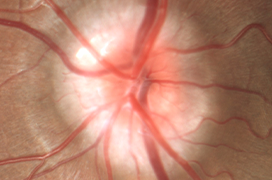Purpose: To analyze patients with optic disc drusen (ODD), with emphasis on modern diagnostics.
Materials and Methods: Research of the literature was conducted, together with a retrospective statistical analysis of patients with ODD. The group included individuals with ODD diagnosed using at least one of the following (ultrasound – USG, optical coherence tomography – OCT, fundus autofluorescence – FAF).
Results: The group consisted of 12 patients (23 eyes), 7 women and 5 men. The mean age was 25 years. The mean observation period was 73 months. In total, 11 patients (22 eyes) had a bilateral finding and 1 patient (1 eye) had a unilateral finding. The mean age was 25 years. Buried drusen were confirmed in 69.6% of cases (8 patients, 16 eyes), superficial drusen were confirmed in 30.4% of cases (4 patients, 7 eyes). Mean best corrected visual acuity (BCVA) and mean intraocular pressure were stable over time (BCVA p = 0.236, IOP p = 0.855). The aforementioned diagnostic methods proved to be equally effective (p = 0.768). In 11 patients (21 eyes) a depression of the retinal nerve fiber layer (RNFL) was recorded. We found a statistically significant decrease of the RNFL over time in reference to the normative database in the superior temporal (p = 0.015), temporal (p = 0.026) and nasal segments (p = 0.011). After separation of superficial and buried drusen the same significant change was found in nasal segment in superficial drusen (p = 0,031). We found no statistically significant difference over time between superficial and buried drusen (p = 0.109–0.999 for individual segments).
Conclusion: ODD are common and visual functions remain stable. Their presence can be confirmed using modern paraclinical methods.

